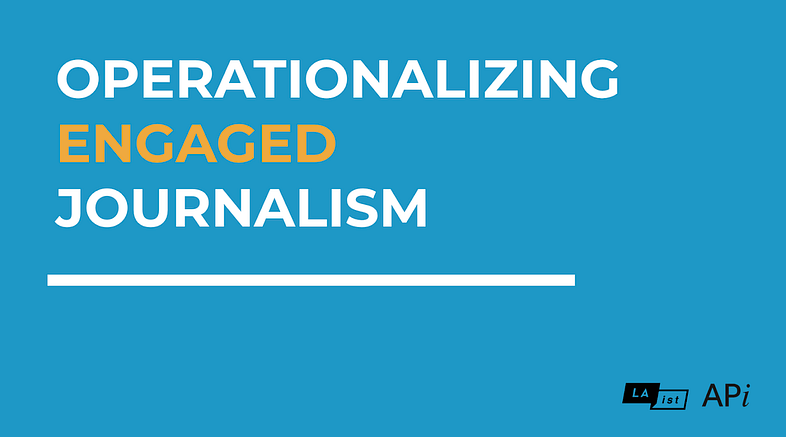How tech challenges are hindering the practice of engaged journalism

This article was previously published on Medium and is republished here with permission.
Engaging community members in your journalism can increase audiences, build trust, and open up new lines of revenue. Tools to help abound: Hearken. Salesforce. Typeform. Google. Airtable. Hustle. PublicInput/Reach. Viafoura. Paperform.
The list goes on.
But while available tools may be growing, they are not necessarily designed with the goals of innovative newsrooms in mind. No one tool serves all the elements that go into engagement work. And while you can attempt to knit them together, the challenge is that many of these tools don’t talk to one another. If you can figure out how to get them to connect, it just adds yet another layer to an already burdened tech stack.
That was a key finding when Southern California Public Radio (LAist) and the American Press Institute launched Operationalizing Engaged Journalism (OEJ). When we asked the participants in the yearlong Knight Foundation–funded program to share the tools they turn to most, it was clear there are issues.
Each of the four newsrooms — WBEZ, WBUR, LAist and Minnesota Public Radio — had a bespoke tech stack, a collection of one-off tools that sometimes work together but more often do not.
Throughout the year, the program focused on ways to operationalize the practice of engaged journalism: how we do the work, how we fund the work and how we make it sustainable. And, over and over again, we returned to the tech-related hurdles we face. (Note: In some instances, the tech does not exist. In other cases, restrictions related to cost or organizational policies prevent their adoption.)
Why connecting the dots matters
Newsrooms that involve community members in their journalism often lean on surveys, or callout forms. In recent months, some of these individual surveys from OEJ newsrooms have garnered thousands of responses. How newsrooms harness those contacts and the information they provide for further engagement and more targeted callouts can sometimes require moving data from one system to another. Extracting this data manually requires a significant amount of time.
At LAist, which uses Typeform as a survey builder, responses are exported to a spreadsheet, standardized, and then imported into an Airtable database. A similar process exists for moving data about those who ask questions through Hearken from its engagement management system into a database of potential contacts. This database can then be used to identify individuals or small groups of people to target with specific callouts.
As MPR Deputy Managing Editor Michael Olson has shared, “Each tool has its own advantages, but it is frustrating that we don’t have a good unified database to work from that helps us manage these relationships more responsively and efficiently. Audience members should be able to have a seamless journey with our content and engage in a variety of ways throughout the process. The diffuse nature of our current state lends itself to one-off or single-channel relationships.”
Tiffany Campbell, who serves as executive editor for digital at WBUR, shared her wish for technology that would better capture engagement and facilitate closing the loop with community members: “As journalists, we’re really good at the soliciting and gathering of information, but none of these tools really help with the ‘loop closing’ in terms of response to the audience member or any kind of follow-up. This is both a technical challenge but also one of point of view: These tools are made from the perspective of extracting information, not sending it back in any kind of individualized manner.”
Many of the engagement tools newsrooms like those participating in OEJ turn to were not built by or for journalists. The few built by journalists launched several years ago, as organizations were starting to experiment with engaged journalism. Those tools have not necessarily kept up with the evolving engagement practices and needs of newsrooms.
As Tiffany shared, “We have a lot of good tools. My only wish is that some of them were designed for our unique use case, particularly the volume and speed at which we publish. Trying to retrofit tools requires overhead costs that sometimes we don’t account for.”
Alex Keefe, engagement editor at WBEZ, notes that his team doesn’t have oversight of all the tools needed to communicate with community members: “The process of doing big text and email campaigns can be a bit onerous and time-consuming because it requires coordination and planning with folks off of our team.”
LAist CCO Kristen Muller did not mince words: “We’ve jury-rigged so many internal systems that it takes as much time to keep them up and running as it does to use them.”
How we fund the work
Of course, technology is but one hurdle to operationalizing engaged journalism fully. We’ve previously written about the need to orient membership and newsletter efforts differently for different platforms as well as the value of shared language.
At a June session at the Public Media Journalists Association (PMJA) conference, LAist Institutional Giving Officer Delaine Ureño discussed ongoing work to shift how she and her team talk about deliverables in grant proposals.
As she shared in a later exchange: “Rather than committing to precise outcomes such as the number of reported stories or event attendees, we now focus on our internal engagement tactics [like listening sessions or research]. This shift provides greater flexibility for our engagement team.”
Delaine worked alongside LAist Senior Editor for Community Engagement Ariel Zirulnick to inform the change to the approach.
“Engagement work is inherently experimental. When we committed to specific deliverables, we encountered numerous challenges aligning them with the goals of our engagement team,” Delaine said.
“The old timeline required us to commit to deliverables before we were able to test the assumptions underpinning them,” Ariel noted. “That meant we didn’t have the space to pivot if we realized midway through that a different deliverable would be stronger. The first step of many engagement efforts is listening — and if we have to commit to deliverables before doing the listening work, we risk committing to things that we later learn aren’t what is most needed.”
She continued, “At this stage in LAist’s engagement journey, we have a pretty good idea of which tactics to employ when, so supporting tactics is a surer investment for the funder.”
How has the shift gone? “Our funders are great! They really ‘get’ the way we work and want to learn about changes in real time,” Delaine said.
MPR Institutional Giving Officer Jay Tacke Peterson notes more “people power” is still needed to make the case for funding engagement. MPR and other newsrooms have a “chicken and egg”–style problem, needing more staff to practice engagement and prove impact to secure funding — while also needing funding to secure the staff. “I think an impact producer or community engagement producer would provide significant value to both our newsroom and our revenue teams,” Jay said.
How we make the work sustainable
To date, foundation support — and the tremendous work of institutional giving teams — has made much of the engaged journalism work possible. But efforts are increasingly focusing on connecting engagement to revenue, whether that’s membership or underwriting/corporate sponsorship.
The tools OEJ newsrooms use today do not make that shift easy.
In addition to the need to move data from one system to another, engagement professionals routinely see missed opportunities to cultivate loyalty. At the same PMJA panel, WBEZ Digital Audience Engagement Manager Taylor Nazon discussed the number of hours they spent trying to build a list of people to invite to a mental health–focused back-to-school event. “It was a lot,” they said, describing how they had to review months of newsletters and click-through data manually to build a list of roughly 5,000 people who had demonstrated interest in education coverage.
According to Engagement Editor Alex Keefe, that work was the single biggest driver of sign-ups for the event.
What Taylor did at WBEZ — and the results they saw from that work — inspired LAist to build a custom automation that creates subscriber segments based on interests (examples include education, politics and environment). This work, although still in the pilot phase, has proved an effective driver of traffic and survey participation.
Finding ways to engage people more deeply in newsletters matters: Newsletters are one of the most effective means of cultivating loyalty and, by extension, building the case for financial support as members.
The lack of interoperability between the engagement tools that newsrooms use and membership systems also affects audience members’ experience: A single person may receive a newsletter, membership appeal, text message and survey all in the same day, signaling that a newsroom has no real idea (or appreciation of) who they are.
At a time when philanthropic support is down, newsrooms have little discretionary energy to invest in addressing these challenges. And, of course, moving around that amount of data creates security concerns.
As Emma Sands Neal, a senior manager on the membership team at MPR, put it, “With the lack of a unified database to track audience engagement, the fundraising teams are unable to be as responsive to the content and to the audience as we would like to be, diffusing the importance and urgency of our requests for community support.”
Fundamentally, the lack of real-time information on how engagement informs conversions to revenue can make it harder to prove the ROI of the work.
Alex at WBEZ noted, “One obstacle to connecting these dots [with revenue] has been a clarity and availability of metrics associated with how folks travel down the engagement [funnel] into the revenue space.”
The Operationalizing Engaged Journalism team consists of Ashley Alvarado, Nation Hahn, Amy Kovac-Ashley, Kristen Muller, and Emily Ristow.







